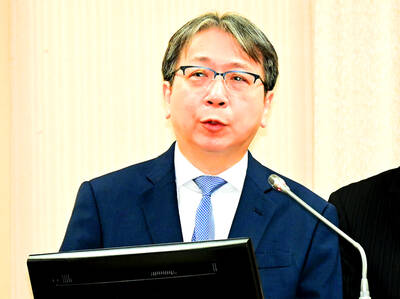Japanese Prime Minister Shigeru Ishiba yesterday said that he would have “frank discussions” with US president-elect Donald Trump, saying that cooperation between them was vital to ensuring a “free and open Pacific.”
“I will have frank discussions with incoming president Trump and lead the alliance to new heights,” Ishiba said in parliament in a key policy address. “Naturally, the US has its own national interest and Japan has its own national interest. That is why I think exchanging opinions frankly and enhancing the national interests of both countries in a synergetic way will help realize a free and open Indo-Pacific.”
Beijing has displayed increasingly assertive behavior in territorial disputes in the Asia-Pacific region, including around Taiwan.

Photo: AFP
Tokyo is also alarmed by nuclear-armed North Korea’s expansion of its missile activities. Trump met North Korean leader Kim Jong-un during his first term.
Ishiba, a self-confessed defense “geek,” has called for the creation of an Asian NATO with its principle of an attack on one being an attack on all.
“The Japan-US security alliance is the foundation of Japan’s diplomacy and security,” Ishiba said. “At the same time, however, the United States receives great strategic benefits from the existence of facilities and areas [controlled by] US forces in Japan.”
In Trump’s first term, then-Japanese prime minister Shinzo Abe appeared to have warm personal relations with the US president, playing golf together several times.
Ishiba and the US president-elect had what the Japanese prime minister called a “very friendly” telephone conversation after Trump’s election win earlier this month.
Key allies Japan and the US are each other’s top foreign investors, and 54,000 US military personnel are stationed in Japan, mostly in Okinawa, east of Taiwan.
Japan has been shedding its strict pacifist stance, moving to obtain “counterstrike” capabilities.
US President Joe Biden and Ishiba’s predecessor, former Japanese prime minister Fumio Kishida, announced a “new era” in defense in April.
Japan is already in the process of doubling its military spending to the NATO standard of 2 percent of GDP, but Trump’s “America First” approach could mean that in his second term he could provide less cash and press Japan to do more.
Trump also caused panic among some of the biggest US trading partners on Monday when he said he would impose tariffs of 25 percent on Mexican and Canadian imports, and 10 percent on goods from China.
Many Japanese exporters, including automakers Toyota and Honda, have plants in Mexico and in Canada. Both firms’ shares fell sharply this week.
Japanese government officials have declined to comment on Trump’s tariff threats, and Ishiba did not address the issue directly yesterday, but Masakazu Tokura, chairman of Japan’s most influential business organization, Keidanren, on Tuesday said that the impact on Japanese firms could be “enormous.”
Trump could also press Japan to join expanded US efforts to limit exports to China, such as semiconductor equipment and artificial intelligence chips, which could hurt Japanese firms.

TRAGEDY STRIKES TAIPEI: The suspect died after falling off a building after he threw smoke grenades into Taipei Main Station and went on a killing spree in Zhongshan A 27-year-old suspect allegedly threw smoke grenades in Taipei Main Station and then proceeded to Zhongshan MRT Station in a random killing spree that resulted in the death of the suspect and two other civilians, and seven injured, including one in critical condition, as of press time last night. The suspect, identified as a man surnamed Chang Wen (張文), allegedly began the attack at Taipei Main Station, the Taipei Fire Department said, adding that it received a report at 5:24pm that smoke grenades had been thrown in the station. One man in his 50s was rushed to hospital after a cardiac arrest

PUBLIC SAFETY: The premier said that security would be tightened in transport hubs, while President Lai commended the public for their bravery The government is to deploy more police, including rapid response units, in crowded public areas to ensure a swift response to any threats, President William Lai (賴清德) said yesterday after a knife attack killed three people and injured 11 in Taipei the previous day. Lai made the remarks following a briefing by the National Police Agency on the progress of the investigation, saying that the attack underscored the importance of cooperation in public security between the central and local governments. The attack unfolded in the early evening on Friday around Taipei Main Station’s M7 exit and later near the Taipei MRT’s Zhongshan

SAFETY FIRST: Double the number of police were deployed at the Taipei Marathon, while other cities released plans to bolster public event safety Authorities across Taiwan have stepped up security measures ahead of Christmas and New Year events, following a knife and smoke bomb attack in Taipei on Friday that left four people dead and 11 injured. In a bid to prevent potential copycat incidents, police deployments have been expanded for large gatherings, transport hubs, and other crowded public spaces, according to official statements from police and city authorities. Taipei Mayor Chiang Wan-an (蔣萬安) said the city has “comprehensively raised security readiness” in crowded areas, increased police deployments with armed officers, and intensified patrols during weekends and nighttime hours. For large-scale events, security checkpoints and explosives

ON ALERT: Taiwan’s partners would issue warnings if China attempted to use Interpol to target Taiwanese, and the global body has mechanisms to prevent it, an official said China has stationed two to four people specializing in Taiwan affairs at its embassies in several democratic countries to monitor and harass Taiwanese, actions that the host nations would not tolerate, National Security Bureau (NSB) Director-General Tsai Ming-yen (蔡明彥) said yesterday. Tsai made the comments at a meeting of the legislature’s Foreign Affairs and National Defense Committee, which asked him and Minister of National Defense Wellington Koo (顧立雄) to report on potential conflicts in the Taiwan Strait and military preparedness. Democratic Progressive Party (DPP) Legislator Michelle Lin (林楚茵) expressed concern that Beijing has posted personnel from China’s Taiwan Affairs Office to its